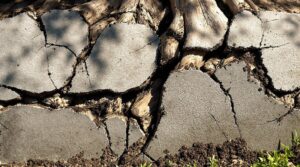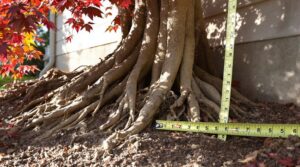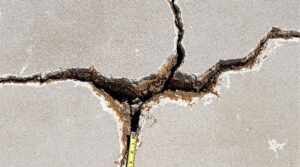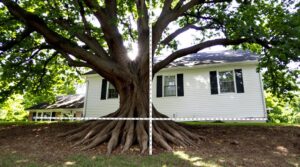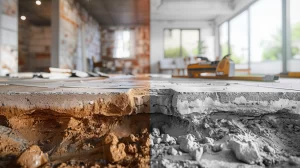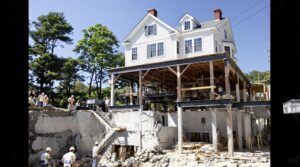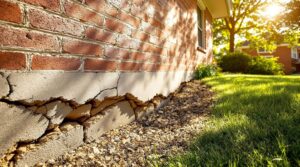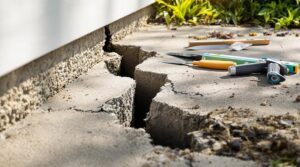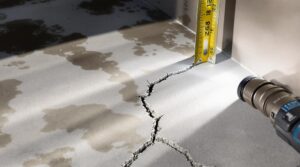Foundation leaks can be a costly and damaging issue for homeowners, with repair costs ranging from $2,000 to $12,000 or more, depending on the severity of the leak, type of foundation, and complexity of the repair. Factors contributing to foundation leaks include drainage issues, cracks, water pressure, soil type, and poor grading. Understanding the causes and symptoms of foundation leaks is essential for effective diagnosis and repair. Exploring the various repair methods and costs can help homeowners make informed decisions.
Key Takeaways
- Foundation leak causes include drainage issues, cracks, water pressure, soil type, and poor grading, requiring thorough examination for diagnosis.
- DIY repair techniques, such as epoxy injection and hydraulic cement, can be effective for minor leaks, but proper preparation is necessary.
- Professional repairs are recommended for extensive leaks, unclear causes, and significant water damage, as they provide detailed assessments and advanced tools.
- Waterproofing and structural repair techniques, such as exterior waterproofing and grout injection, can prevent further damage and ensure structural integrity.
- Repair costs vary widely, ranging from $2,000 to $12,000, depending on the type of foundation, severity of the leak, and repair method.
Understanding Foundation Leak Causes and Symptoms
Although foundation leaks can be caused by a multitude of factors, understanding the underlying causes and recognizing the symptoms are essential steps in preventing and addressing these issues.
Foundation types, such as those constructed from concrete or masonry, can be susceptible to leaks due to poor drainage, cracks, and excessive water pressure.
Soil moisture also plays a significant role, as certain types of soil, like clay, can increase the risk of foundation leaks.
Factors such as the age of the home, climate, and landscaping can also contribute to the likelihood of a foundation leak.
Understanding these factors can help homeowners identify potential risks and take proactive measures to prevent leaks.
Poor grading around the home can lead to water pooling against the foundation, increasing the likelihood of a leak.
Identifying and Diagnosing Foundation Leaks
Identifying and diagnosing foundation leaks requires a thorough examination of the foundation, walls, and floors for signs of water damage, cracks, and discoloration.
To accurately diagnose the cause of a foundation leak, it is essential to employ various detection methods, including visual inspections, crack analysis, and the use of specialized diagnostic tools. One such tool is the acoustic listening device, which can help pinpoint the exact location of a leak by amplifying the sound of water flowing through pipes.
Identifying Foundation Leak Signs
When foundation leaks occur, the resulting damage can be extensive and costly, emphasizing the importance of recognizing the signs of a leak early on.
Through a thorough foundation inspection and moisture detection, homeowners can identify warning signs. Persistent dampness, visible cracks, uneven floors, mold growth, and water stains are common interior indicators.
Exterior signs include crumbling concrete, shifting soil, and gaps between the foundation and structure. Homeowners should also inspect for rust or rot, efflorescence, and unexplained spikes in utility bills. Early detection of persistent dampness is crucial to prevent further complications and ensure timely repairs.
Regular inspections can help prevent significant structural issues and health hazards. Addressing small issues promptly can prevent costly repairs and maintain home stability.
Diagnosing Foundation Leak Causes
How do homeowners pinpoint the underlying causes of foundation leaks to prevent further damage and costly repairs? Conducting a thorough foundation inspection and leak detection process is essential. This involves identifying signs of water intrusion, such as cracks, discoloration, and settling floors. Homeowners should also investigate potential water sources, including groundwater movement, poor drainage, and broken pipes.
| Common Causes | Description |
|---|---|
| Cracks and Gaps | Cracks in foundation walls or floors indicate potential leaks |
| Groundwater Movement | Moving groundwater can seep into the foundation |
| Settling Floors | Uneven or sinking floors indicate possible erosion beneath the house |
| Poor Drainage | Inadequate drainage around the home leads to water pooling and soil saturation |
| Broken Pipes | Leaks in underground pipes can cause water infiltration |
Foundation Leak Detection Tips
Foundation leak detection allows homeowners to pinpoint the location and severity of water intrusion, enabling targeted repairs to prevent further damage.
To detect foundation leaks effectively, homeowners must recognize signs of water intrusion and distinguish them from common misconceptions and foundation leak myths. Visible signs include crumbling concrete, gaps between the foundation and structure, and sinking floors.
Indicators inside the home consist of water accumulation, foundation cracks, efflorescence, musty smells, and peeling paint. Additional detection methods include water tests, inspecting tack strips, and monitoring water usage.
Critical areas to inspect include old plumbing systems, clogged gutters, and tree roots beneath the construction. Regular inspections and examinations of the plumbing system can help prevent undetected slab leaks and reduce the need for costly repairs.
DIY Foundation Leak Repair Techniques and Materials
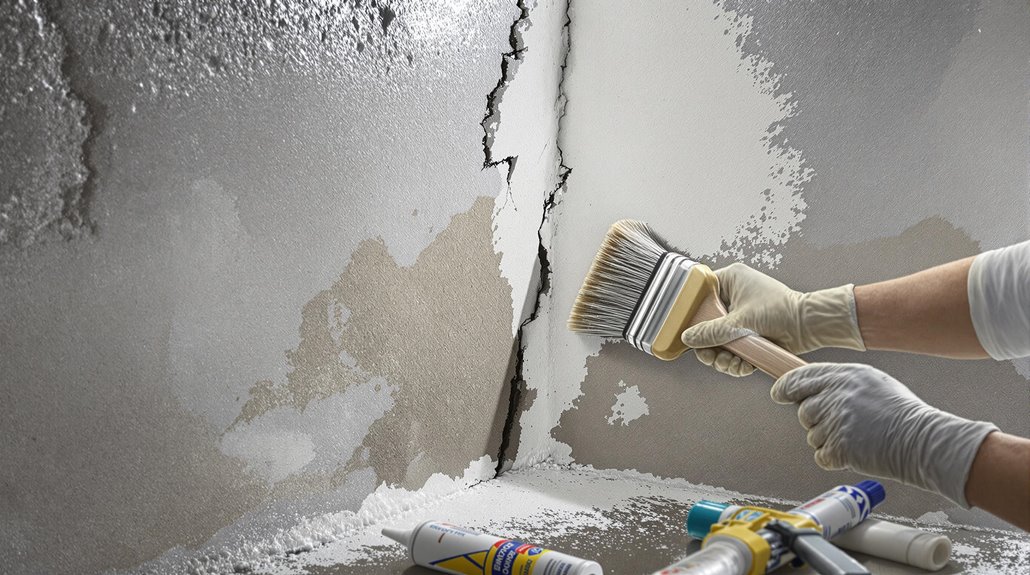
Although various methods exist for addressing foundation leaks, a thorough understanding of DIY techniques and materials is essential for homeowners seeking to mitigate water damage and prevent future issues.
Epoxy injection and hydraulic cement are fundamental techniques used in DIY foundation leak repairs. Epoxy injection involves injecting epoxy or polyurethane foam into cracks to create a waterproof barrier, suitable for static cracks in concrete foundations.
Hydraulic cement is a fast-setting compound that expands as it cures, effectively plugging active leaks and ideal for dynamic or shifting cracks. Both methods require thorough cleaning and preparation before application.
When to Hire a Professional for Foundation Leak Repairs
Understanding the fundamentals of DIY foundation leak repair techniques and materials is essential for successful repairs; however, certain situations necessitate the expertise of a professional. When the leak is extensive, the cause is unclear, or significant water damage has occurred, professional help is required. Advanced tools and machinery are often necessary for effective repairs, which professionals have access to.
| Situation | Risk | Professional Benefit |
|---|---|---|
| Extensive leak | Structural damage | Thorough inspections |
| Unclear cause | Increased damage | Expert knowledge and experience |
| Significant water damage | Safety risks | Access to advanced tools |
A professional foundation repair specialist can conduct a detailed leak assessment, identify the source and extent of the leak, and provide a thorough repair plan to restore the foundation's integrity and stability.
Professional Foundation Leak Repair Methods and Solutions
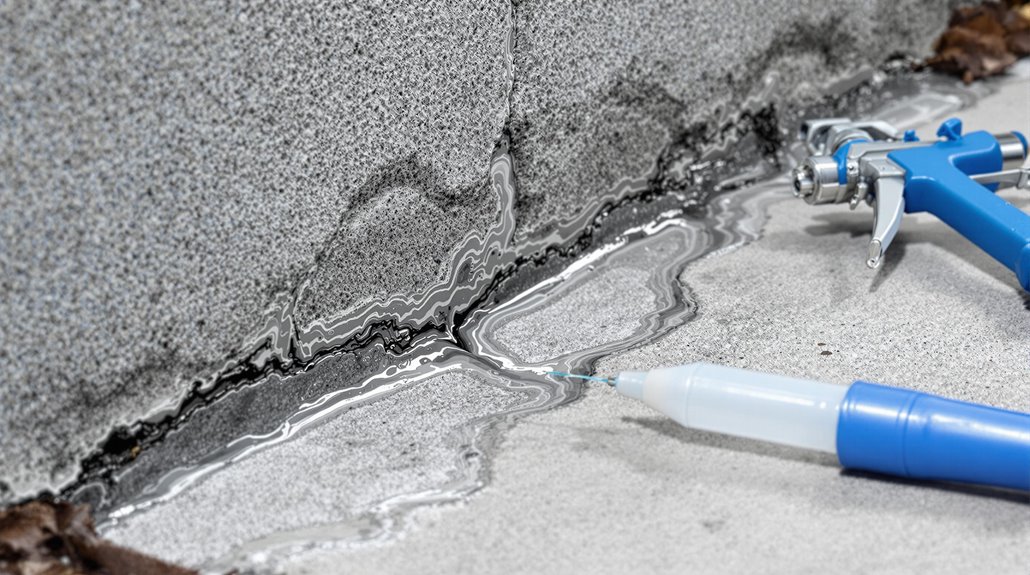
Foundation stabilization methods, such as carbon fiber straps and epoxy injection, are employed to reinforce compromised foundation walls and restore structural integrity.
Exterior waterproofing solutions, including the application of waterproof barriers and French drains, aim to prevent water intrusion and alleviate pressure on the foundation walls.
Structural repair techniques, such as hydraulic cement and polyurethane sealants, are used to address cracks and joints, ensuring a durable and long-lasting repair.
Foundation Stabilization Methods
How can compromised foundations be effectively stabilized and restored to prevent further damage and water infiltration?
Foundation stabilization methods are employed to address structural weaknesses and prevent further settlement. This process involves various techniques designed to target specific foundation issues.
Some of the most effective foundation stabilization techniques include:
- Piering methods, such as steel, helical, and concrete piers, to support the foundation and distribute weight evenly
- Slab stabilization using polyurethane foam jacking to lift sunken concrete foundations
- Underpinning to extend and reinforce existing footings
- Epoxy injection to seal and restore structural integrity
- Grouting to inject cement mixtures into the ground and stabilize soil, filling voids beneath the foundation
Exterior Waterproofing Solutions
When addressing foundation leaks and related structural damage, exterior waterproofing solutions play a vital role in preventing further water infiltration and protecting the foundation from long-term deterioration.
Exterior waterproofing involves applying waterproofing materials to the exterior of the foundation, often requiring excavation to access the affected area. A proper exterior drainage system is also essential in directing water away from the foundation.
This can be achieved through the installation of drainage systems, such as French drains, and the application of waterproof membranes and coatings. Flexible, seamless membranes are often more effective than traditional solid sheets.
A professional assessment is necessary to determine the best waterproofing method for specific foundation conditions, taking into account geographic location, climate, soil conditions, and water table levels.
Structural Repair Techniques
Addressing the root causes of foundation leaks often requires a thorough approach that combines exterior waterproofing solutions with targeted structural repairs.
A structural integrity assessment is essential to identify the most effective foundation repair techniques.
The following advanced repair methods are commonly employed by professionals:
- Grout injection for filling voids beneath the foundation
- Stitching for re-establishing tensile strength across fractured sections
- Drilling and key-plugging for preventing transverse movement
- Grouting for wide cracks involving thorough cleaning and sealing
- Polyurethane sealant for flexible sealing of joints and cracks
These techniques guarantee a durable and long-lasting solution to foundation leaks, restoring the structural integrity of the building.
Professional contractors use specialized equipment and expertise to execute these methods, providing a strong foundation for years to come.
Prevention and Maintenance Strategies for Foundation Leaks
Preventing foundation leaks is a more cost-effective approach than repairs, as it eliminates the need for costly and extensive repairs, reduces the risk of damage to the structure and its contents, and minimizes disruptions to occupants.
Effective prevention strategies include preventative landscaping measures, such as ensuring the ground around the home slopes away from the foundation and using granular material for backfill.
Regular maintenance is also essential, including scheduling regular inspections of the foundation and basement, maintaining installed water control systems, and inspecting and cleaning gutters and downspouts.
By implementing these strategies, homeowners can greatly reduce the risk of foundation leaks and associated damage.
Regular maintenance and inspections can also help detect potential issues early, allowing for prompt repairs and minimizing costs.
Cost Considerations for Foundation Leak Repairs and Prevention

While the importance of preventing foundation leaks cannot be overstated, the reality is that many homeowners will ultimately face the need for repairs. The costs associated with repairing a foundation leak can be substantial, and several factors contribute to the final bill.
- Type of foundation: Different types have varying repair costs, e.g., concrete slab foundation repair costs between $2,000 to $7,000.
- Severity of the leak: More severe leaks cost more, ranging from $2,000 to $6,000, and may include accessibility issues.
- Waterproofing solutions: Installing an exterior drainage system, for instance, can cost $5,000 to $10,000.
- Repair method: Methods like epoxy injections are relatively affordable, while extensive exterior waterproofing can be costly.
- House size and location: Larger homes and specific locations may drive up repair costs.
Comparing DIY and Professional Foundation Leak Repair Costs
Foundation leak repairs can take various forms, ranging from minor crack sealing to extensive waterproofing solutions. A cost analysis reveals that DIY repairs can range from $35 to $1,000, while professional repairs can cost between $2,000 and $12,000. When considering the best approach to foundation leak repairs, it’s essential to weigh the long-term benefits of professional services against the initial savings of a DIY project. Many homeowners choose to invest in concrete foundation repair techniques that not only fix existing issues but also prevent future problems. Ultimately, the decision will depend on the severity of the leaks and the homeowner’s budget and skills.
The disparity in costs is largely due to the complexity and scope of the repairs. DIY methods are suitable for small hairline cracks and minor settling, but carry risks of incorrect application and further damage. In contrast, professional methods address the underlying cause of the leak and provide lasting results.
Factors such as soil conditions, property size, and geographic location influence professional repair costs. A thorough cost analysis must consider these factors to determine the most effective and cost-efficient solution.
DIY risks and limitations must also be weighed against the benefits of professional expertise.
Long-term Savings and Benefits of Preventative Foundation Leak Repairs
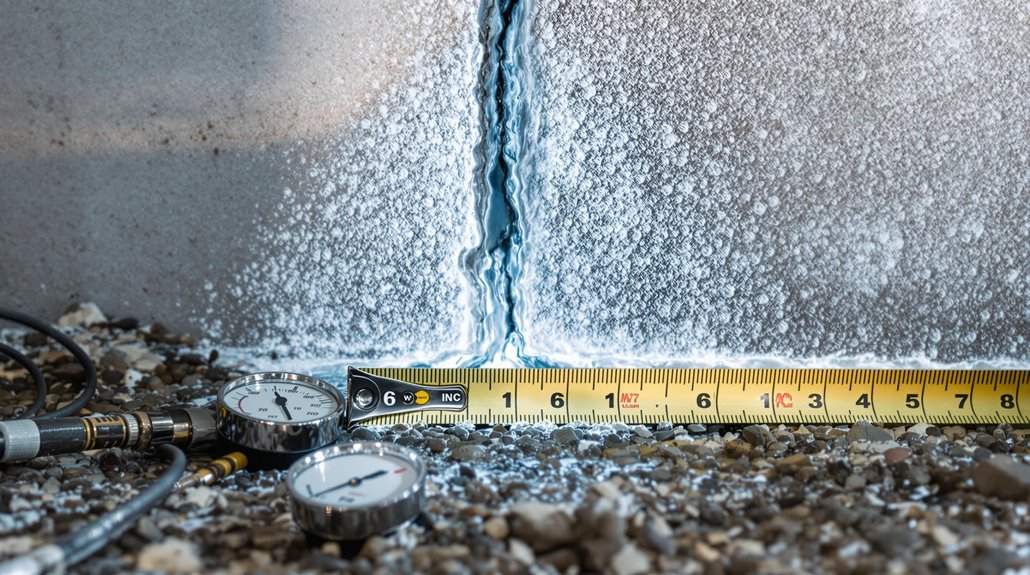
When homeowners invest in regular inspections and prompt foundation leak repairs, they can greatly minimize the risk of costly and extensive damage to their property.
Implementing preventive measures through regular inspections is essential for budget planning, as it reduces the likelihood of costly repairs down the line.
Some key benefits of preventative foundation leak repairs include:
- Early detection of potential issues before they cause extensive damage
- Reduced risk of costly repairs through preventive maintenance
- Extended life of the foundation
- Improved long-term stability of the home
- Enhanced safety through regular inspections and prompt action
Regular foundation inspections and repairs are vital for maintaining the structural integrity and value of a home.
Frequently Asked Questions
Can I Sell My House With a Foundation Leak?
A homeowner can sell their house with a foundation leak, but they must provide full foundation disclosure to potential buyers, as required by law, which can impact property value and potentially lead to lower offers.
How Long Does a Foundation Leak Repair Typically Take?
Like the delicate art of fixing a puzzle, repairing a foundation leak requires precision. Repair duration varies due to construction factors, such as severity of damage and type of foundation, typically taking anywhere from a few days to several weeks.
Will My Homeowner's Insurance Cover Foundation Leak Repairs?
Homeowners' insurance policies may cover foundation leak repairs if the damage is caused by a covered peril, with repair coverage typically extending to sudden physical losses, but exclusions and limitations often apply to settlement and maintenance issues.
Can Foundation Leaks Cause Health Problems for Occupants?
Like a stealthy invader, a foundation leak can release a torrent of health problems, compromising a home's structural integrity and exposing occupants to hazardous mold exposure, airborne pathogens, and contaminated water, putting them at risk.
Are Foundation Leak Repairs a Tax-Deductible Home Improvement?
Foundation leak repairs are generally not tax-deductible as home improvements, but may qualify for tax benefits if part of a home office or rental property, with repair costs proportional to the dedicated space.
